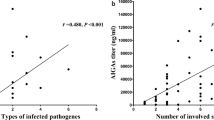Summary
A direct antiglobulin test (DAT) was performed in 70 patients with anti-HIV antibodies (group A: seropositive patients without or with minimal disease and group B: AIDS patients with or without malignancies). A positive DAT was found in 24 of 70 patients (34%, significantly higher compared to 0.1% in healthy controls) and a higher prevalence of positive DAT was observed in group B than in group A patients (55% versus 21% p<0.01). When comparing DAT-positive and negative patients within the same clinical group, no significant difference is seen in haemoglobin levels. There is no difference in serum bilirubin, haptoglobin or reticulocyte count between DAT-positive and negative patients altogether or in the same clinical group. AZT therapy seems to exert no significant influence on the onset of a positive DAT. The results confirm a high prevalence of positive DAT in patients with HIV antibodies, mainly in worse clinical conditions, and suggest that a positive DAT might be a prognostic factor in the clinical course of the disease.
Zusammenfassung
Bei 70 Patienten mit anti-HIV-Antikörpern wurde ein direkter Antiglobulin-Test durchgeführt. In Gruppe A waren seropositive Patienten ohne oder mit minimalen Krankheitszeichen, in Gruppe B AIDS-Patienten mit oder ohne maligne Erkrankung. Bei 24 von 70 Patienten (34%) war der DAT positiv. Im Vergleich dazu waren bei gesunden Kontrollen nur 0,1% positiv. Neben diesem signifikanten Unterschied fanden sich auch signifikante Unterschiede zwischen den beiden Gruppen mit 55% positivem DAT in Gruppe B und 21% in Gruppe A (p<0,01). DAT-positive und -negative Patienten in denselben klinischen Gruppen zeigten in ihren Hämoglobinspiegeln keine signifikanten Unterschiede. Auch fanden sich insgesamt und in den beiden klinischen Gruppen keine Unterschiede in den Werten von Serumbilirubin. Haptoglobin oder Retikulozytenzahlen bei DAT-positiven und -negativen Patienten. Die Behandlung mit AZT hat offensichtlich keinen wesentlichen Einfluß darauf, wann der DAT positiv wird. Unsere Ergebnisse bestätigen, daß bei Patienten mit HIV-Antikörpern eine hohe Rate an positiven DAT besteht und sich vor allem bei den ungünstigen klinischen Stadien positive Testergebnisse einstellen, so daß der positive DAT als prognostischer Faktor für den klinischen Verlauf der Erkrankung angesehen werden kann.
Similar content being viewed by others
References
McGinnis, M. H., Macher, A. M., Rook, A. H., Alter, H.-J. Red cell autoantibodies in patients with acquired immune deficiency syndrome. Transfusion 26 (1986) 405–409.
Toy, P. T., Reid, M. E., Burns, M. Positive direct antiglobulin test associated with hyperglobulinemia in acquired immunedeficiency syndrome (AIDS). Am. J. Hematol. 19 (1985) 145–150.
Telen, M. J., Roberts, K. B., Bartlett, J. A. HIV-associated autoimmune haemolytic anaemia: report of a case and review of the literature. J. Acquir. Immune Defic. Syndr. 3 (1990) 933–937.
Bordin, J. O., Kerabauy, J., Souza-Pinto, J. C., Conti, E., Accetturi, C. A., Kishiwada, M. A. M., Novo, N. F., Castelo, A. Quantitation of red cell bound IgG by an enzyme-linked antiglobulin test in human immunodeficiency virus infected persons. Transfusion 32 (1992) 426–429.
Puppo, F., Torresin, A., Lotti, G., Balleari, E., Orlando, G., Indiveri, F. Autoimmune haemolytic anemia and human immunodeficiency virus (HIV) infection. Ann. Intern. Med. 109 (1989) 249–250.
Rapoport, A. P., Rowe, J. M., McMican, A. Life-threatening autoimmune haemolytic anemia in a patient with the acquired immune-deficiency syndrome. Transfusion 28 (1988) 190–191.
Gaffuri, L., Repetto, L., Rossi, E., Oliva, C., Rosso, R., Rizzo, F. Haemolytic anaemia with positive cryoglobulin test in a HIV positive man. Eur. J. Cancer 27 (1991) 304.
Van der Lelic, J., Lange, J. M. A., Vos, J. J. E., Van Dalen, C. M., Danner, S. A., von dem Borne, A. E. G. Kr. Autoimmunity against blood cells in human immunodeficiency-virus (HIV) infection. Br. J. Haematol. 67 (1987) 109–114.
Dodsworth, H., Wiener, E. Non-immune nature of anaemia in HIV infection. Br. J. Haematol. 68 (1988) 498–499.
Taneja-Uppal, N., Rappaport, S., Berger, B. J., Davidson, E., Rahal, J. J. Human immunodeficiency virus (HIV) infection and haemolytic anemia. Ann. Intern. Med. 111 (1989) 340–341.
Human Immunodeficiency Virus (HIV) Infection Classification Morbid Mortal Weekly Rep. 36 (1987) 1S-20S.
LaPierre, Y., Rigal, D., Adam, J., Josef, D., Meyer, F., Greber, S., Drot, C. The gel test: a new way to detect red cell antigen-antibody reactions. Transfusion 30 (1990) 109–113.
Walker, R. H. (ed.): Technical manual. 10th ed. Arlington: American Association of Blood Banks, 1990.
Scott, M. L. The principles and applications of solid phase blood group scrology. Transf. Med. Rev. 5 (1991) 60–72.
Zon, L. I., Arkin, C., Groopman, J. E. Haematologic manifestations of the human immune deficiency virus (HIV). Br. J. Haematol. 66 (1987) 251–256.
Ganser, A. Abnormalities of hematopoiesis in the acquired immunodeficiency syndrome. Blut 56 (1988) 49–53.
Scadden, D. T., Zon, L. I., Groopman, J. E. Pathophysiology and management of HIV associated hematologic disorders. Blood 74 (1989) 1455–1463.
Brizzi, M. F., Porcu, P., Portieri, A., Pegoraro, L. Haematologic abnormalities in the acquired immunodeficiency syndrome. Haematologica 75 (1990) 454–463.
Calenda, V., Chermann, J. C. The effects of HIV on hematopoiesis. Eur. J. Haematol. 48 (1992) 181–186.
Inada, Y., Lange, M., McKinley, G. F., Sonnabend, J. A., Fonville, T. W., Kanemitsu, T., Tanaka, M., Clark, W. S. Hematologic correlates and the role of erythrocyte CR1 (C3b receptor) in the development of AIDS. AIDS Res. 2 (1986) 235–247.
Chow, F. P. R., Hamburger, A. W. In vivo evaluation of the anemia induced by azidothymidine (AZT) in a murine model of AIDS. Eur. J. Haematol. 47 (1991) 91–97.
Author information
Authors and Affiliations
Rights and permissions
About this article
Cite this article
De Angelis, V., Biasinutto, C., Pradella, P. et al. Clinical significance of positive direct antiglobulin test in patients with HIV infection. Infection 22, 92–95 (1994). https://doi.org/10.1007/BF01739012
Received:
Accepted:
Issue Date:
DOI: https://doi.org/10.1007/BF01739012




